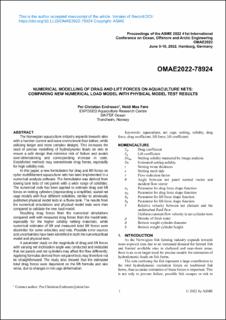| dc.contributor.author | Endresen, Per Christian | |
| dc.contributor.author | Føre, Heidi Moe | |
| dc.date.accessioned | 2023-02-03T11:12:32Z | |
| dc.date.available | 2023-02-03T11:12:32Z | |
| dc.date.created | 2023-01-30T13:12:13Z | |
| dc.date.issued | 2022 | |
| dc.identifier.isbn | 978-0-7918-8588-8 | |
| dc.identifier.uri | https://hdl.handle.net/11250/3048255 | |
| dc.description.abstract | The Norwegian aquaculture industry expands towards sites with a harsher current and wave environment than before, while utilizing larger and more complex designs. This increases the need of precise modelling of hydrodynamic loads on nets to ensure a safe design that minimize risk of failure and avoids over-dimensioning and corresponding increase in costs. Established methods may overestimate drag forces, especially for high solidity nets. In this paper, a new formulation for drag and lift forces on nylon multifilament aquaculture nets has been implemented in a numerical analysis software. The formulation was derived from towing tank tests of net panels with a wide range of solidities. The numerical code has been applied to estimate drag and lift forces on netting cylinders (representing a simplified, scaled net cage model) with four different solidities, similar to previously published physical model tests in a flume tank. The results from the numerical simulations and physical model tests were then compared to validate the new load model. Resulting drag forces from the numerical simulations compared well with measured drag forces from the model tests, especially for the higher solidity netting materials, while numerical estimates of lift and measured total lift forces were dissimilar for some velocities and nets. Possible error-sources and uncertainties have been identified in both the numerical load model and physical tests. A parameter study on the magnitude of drag and lift forces with varying net inclination angle was conducted and indicated that net panels and net cylinders may affect the flow differently. Applying formulas derived from net panel tests may therefore not be straightforward. The study also showed that the estimated total drag forces were dependent on the lift formula and vice versa, due to changes in net cage deformation. | en_US |
| dc.language.iso | eng | en_US |
| dc.publisher | ASME | en_US |
| dc.relation.ispartof | ASME 2022 41st International Conference on Ocean, Offshore and Arctic Engineering. Volume 4: Ocean Space Utilization | |
| dc.title | Numerical Modelling of Drag and Lift Forces on Aquaculture Nets: Comparing New Numerical Load Model With Physical Model Test Results | en_US |
| dc.title.alternative | Numerical Modelling of Drag and Lift Forces on Aquaculture Nets: Comparing New Numerical Load Model With Physical Model Test Results | en_US |
| dc.type | Chapter | en_US |
| dc.type | Peer reviewed | en_US |
| dc.description.version | acceptedVersion | en_US |
| dc.rights.holder | Copyright 2022 ASME | en_US |
| dc.source.pagenumber | 1-10 | en_US |
| dc.identifier.doi | 10.1115/OMAE2022-78924 | |
| dc.identifier.cristin | 2118379 | |
| dc.relation.project | Norges forskningsråd: 237790 | en_US |
| cristin.ispublished | true | |
| cristin.fulltext | postprint | |
| cristin.qualitycode | 1 | |
